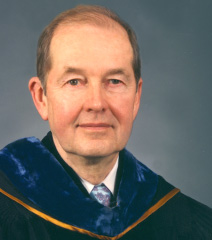Edward Weidner
Weidner's Legacy

Edward W. Weidner
October 1966 - June 1986
Edward W. Weidner was named the University’s first chancellor in Oct. 1966, and served in that post until he stepped down in 1986, after which he taught classes and served as director of the University’s Cofrin Arboretum for a time. He officially retired in 1989 and was awarded the title chancellor emeritus. Beginning in 1987, Weidner was instrumental in the fund drive that led to construction of the performing arts center on the campus that ultimately bore his name. He was named project director for the facility in April 1990, and served until a permanent director was hired.
At UW-Green Bay:
As the University’s first chancellor and first employee, Weidner was instrumental in defining the mission, academic plan, and campus of the new institution. The Board of Regents approved a preliminary academic plan in March 1967, and a mission philosophy statement in Feb. 1968. A comprehensive development plan for the University’s campus was published in Nov. 1968, and its basic guidelines influence campus development today.
The University began offering classes in fall 1968 in the former two-year UW Center, and the first buildings on the new campus opened in fall 1969. Weidner placed much emphasis on university-community involvement and coined the term, “communiversity.” He guided the University from its beginning during the turbulent ‘60s and the dawning of the environmental movement to a much different era two decades later, and although the University’s internal structure and academic program evolved to meet new realities and challenges, the academic philosophy remained centered around the value of a liberal arts education, interdisciplinarity, and practical problem solving. Weidner was instrumental in securing gifts that enabled the University to begin developing an arboretum around its periphery, and others that provided named professorships for outstanding faculty scholars, scholarships, and other benefits to the University. He successfully led the effort to move the University’s athletics program to Division I status. By the time Weidner stepped down, the University had 5,000 students on a campus with nine major academic buildings, a student union, and a sports center, and was developing on-campus student housing by acquiring an apartment complex adjacent to campus and constructing four new residence halls.
Weidner published and spoke widely on higher education in general and on UW-Green Bay in particular. He participated in several professional organizations relating to his academic interests. He was active in the American Council on Education, the Association of American Colleges, and the American Association of State Colleges and Universities, and many other organizations related to education. Weidner served on the United Nations Environment Programme’s North American Advisory Group, and on the board of The Nature Conservancy of Wisconsin. He was active while chancellor and continued to be active in retirement on many area boards and advisory groups.
Education:
Bachelor’s, master’s, and Ph.D. degrees from the University of Minnesota (political science).
Prior to joining UW-Green Bay:
Weidner came to Green Bay from the University of Kentucky where he was a professor of political science and director of the Center for Developmental Change. Prior to that he spent four years as vice chancellor of the Institute of Advanced Projects at the East-West Center at the University of Hawaii. He previously had taught at the University of California, Los Angeles, the University of Minnesota, and at Michigan State University, where he was director of the Institute of Research on Overseas Programs. He served on the President’s Task Force on Foreign Economic Assistance in 1961, and had consulted and completed various assignments in Southeast Asia, Latin America, Europe, and the Middle East.